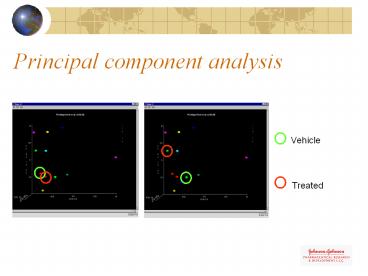Principal component analysis - PowerPoint PPT Presentation
1 / 16
Title:
Principal component analysis
Description:
Morphologic Analysis Correlates with Gene Expression Changes in Cultured F344 ... of growth control, and imperfect DNA repair leading to carcinogenesis. ... – PowerPoint PPT presentation
Number of Views:36
Avg rating:3.0/5.0
Title: Principal component analysis
1
Principal component analysis
2
Heat Map Cluster Analysis
3
Applications of genomics in toxicology
- Mechanistic Toxicology
- Investigative toxicology
- Hypothesis generation
- Risk assessment
- Understanding the mechanism of toxicity at the
molecular level - Predictive toxicology
- Compound avoidance
- Elimination of liabilities
- Compound selection
- Select compound with least toxic liability from a
series - Compound management
- Tailor conventional studies and perform timely
investigational toxicology studies
4
Where Predictive Mechanistic Toxicology Fit
Clinical Development
Drug Discovery
PreClinical Testing
Phase IV
FDA
Mechanistic studies
Pattern-based
Mechanism-based
Predictive screens
5
Mechanistic Toxicology Using Genomics/Transcriptom
ics
6
Morphologic Analysis Correlates with Gene
Expression Changes in Cultured F344 Rat
Mesothelial CellsL. M. Crosby, K. S. Hyder, A.
B. DeAngelo, T. B. Kepler, B. Gaskill, G. R.
Benavides, L. Yoon, and K. T. Morgan (Toxicol
Appl Pharmacol. 2000 Dec 15169(3)205-21.)
- The gene expression pattern of mesothelial cells
in vitro was determined after 4 or 12 h exposure
to the rat mesothelial, kidney, and thyroid
carcinogen and oxidative stressor potassium
bromate (KBrO3). - Gene expression changes observed using cDNA
arrays indicated oxidative stress, mitotic
arrest, and apoptosis in treated immortalized rat
peritoneal mesothelial cells.
7
Morphologic Analysis Correlates with Gene
Expression Changes in Cultured F344 Rat
Mesothelial CellsL. M. Crosby, K. S. Hyder, A.
B. DeAngelo, T. B. Kepler, B. Gaskill, G. R.
Benavides, L. Yoon, and K. T. Morgan (Toxicol
Appl Pharmacol. 2000 Dec 15169(3)205-21.)
8
Morphologic Analysis Correlates with Gene
Expression Changes in Cultured F344 Rat
Mesothelial CellsL. M. Crosby, K. S. Hyder, A.
B. DeAngelo, T. B. Kepler, B. Gaskill, G. R.
Benavides, L. Yoon, and K. T. Morgan (Toxicol
Appl Pharmacol. 2000 Dec 15169(3)205-21.)
- Increases occurred in oxidative stress responsive
genes transcriptional regulators protein repair
components DNA repair components lipid peroxide
excision enzyme PLA2 and apoptogenic components.
- Numerous signal transduction, cell membrane
transport, membrane-associated receptor, and
fatty acid biosynthesis and repair components
were altered - Propose a model for KBrO3-induced carcinogenicity
in the F344 rat mesothelium is proposed, whereby
KBrO3 generates a redox signal that activates p53
and results in transcriptional activation of
oxidative stress and repair genes, dysregulation
of growth control, and imperfect DNA repair
leading to carcinogenesis.
9
Predictive Toxicology
- Prediction Probability
- Best estimate from available information
- Does not provide definitive result or answer
- Provides alerts and/or guidance
10
Predictive Toxicology in Compound Management
- In Drug Development
- Selection/deselection of compounds
- Initiate a proactive investigative toxicology
programme - to be forewarned is to be forearmed
- Risk assessment
- Conventional toxicology studies test the
hypotheses generated by predictive toxicology - (hazard dose response risk assessment)
- Decision making using both sets of data
11
Pattern-based Predictive Screens Using
Genomics/Transcriptomics
12
Genomic Profiling - comparing toxins From Ulrich
Friend (2002) Nature Reviews, 184-88
13
Toxicogenomics-based Discrimination of Toxic
Mechanism in HepG2 Human Hepatoma Cells ME
Burczynski, M McMillian, J Ciervo, L Li, JB
Parker, RT Dunn, S Hicken, S Farr MD Johnson
Toxicological Sciences 58, 399-415 2000
- Initial comparisons of the expression patterns
for 100 toxic compounds using a 250 gene
microarray failed to discriminate between
toxicant classes - However, taking multiple replicate observations
of gene expression for cisplatin, diflunisal
flufenamic acid yielded a reproducible
discriminatory subsets of genes. - The subsets not only discriminated between the
three compounds but also showed predictive value
for the other 100 toxic compounds tested. - Supervised learning
- Based on statistics and understanding of mechanism
14
Application of genomics/transcriptomics in
toxicology - What has been learned?
- Hypotheses can be generated
- Mechanisms can be unravelled
- Profiles can discriminate between compounds
- Understanding molecular mechanisms helps
- Profiles can classify compounds/mechanisms
- Not a standalone technology to identify toxicity
(never an expectation)
15
Application of genomics/transcriptomics in
toxicology - Current understanding
- Rapid hypothesis generation
- Rapid classification
- Additive not standalone
- Particularly for mechanistic investigations
- Questions of sensitivity/reproducibility
- Most gene expression changes at high doses
- Interlab variation
- Developing more realistic expectations through
collaboration and open debate - ILSI, MGED/EBI database standard
16
A Few References
- Review of Arrays and Data analysis
- Lockhart Winzeler (2000) genomics, gene
expression and DNA arrays. Nature 405827-836. - Hypothesis generation
- Crosby et al (2000) Morphologic analysis
correlates with gene expression changes in
cultured F344 rat mesothelial cells. Toxicol.
Applied Pharmacol. 169205-221. - Screening
- Burczynski et al (2000) Toxicogenomics-based
discrimination of toxic mechanism in HepG2 human
hepatoma cells. Toxicological Sciences
58399-415. - Waring et al (2001) Clustering of hepatotoxins
based on mechanism of toxicity using gene
expression profiles. Toxicology and Applied
Pharmacology175, 28-42.































